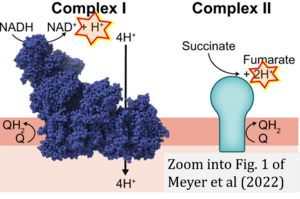Meyer 2022 New Phytol
| Meyer EH, Letts JA, Maldonado M (2022) Structural insights into the assembly and the function of the plant oxidative phosphorylation system. New Phytol 235:1315-29. https://doi.org/10.1111/nph.18259 |
Meyer EH, Letts JA, Maldonado M (2022) New Phytol
Abstract: One of the key functions of mitochondria is the production of ATP to support cellular metabolism and growth. The last step of mitochondrial ATP synthesis is performed by the oxidative phosphorylation (OXPHOS) system, an ensemble of protein complexes embedded in the inner mitochondrial membrane. In the last 25 yr, many structures of OXPHOS complexes and supercomplexes have been resolved in yeast, mammals, and bacteria. However, structures of plant OXPHOS enzymes only became available very recently. In this review, we highlight the plant-specific features revealed by the recent structures and discuss how they advance our understanding of the function and assembly of plant OXPHOS complexes. We also propose new hypotheses to be tested and discuss older findings to be re-evaluated. Further biochemical and structural work on the plant OXPHOS system will lead to a deeper understanding of plant respiration and its regulation, with significant agricultural, environmental, and societal implications.
• Bioblast editor: Gnaiger E
Hydrogen ion ambiguities in the electron transfer system
Communicated by Gnaiger E (2023-10-08) last update 2023-11-10
- Electron (e-) transfer linked to hydrogen ion (hydron; H+) transfer is a fundamental concept in the field of bioenergetics, critical for understanding redox-coupled energy transformations.
- However, the current literature contains inconsistencies regarding H+ formation on the negative side of bioenergetic membranes, such as the matrix side of the mitochondrial inner membrane, when NADH is oxidized during oxidative phosphorylation (OXPHOS). Ambiguities arise when examining the oxidation of NADH by respiratory Complex I or succinate by Complex II.
- Oxidation of NADH or succinate involves a two-electron transfer of 2{H++e-} to FMN or FAD, respectively. Figures indicating a single electron e- transferred from NADH or succinate lack accuracy.
- The oxidized NAD+ is distinguished from NAD indicating nicotinamide adenine dinucleotide independent of oxidation state.
- NADH + H+ → NAD+ +2{H++e-} is the oxidation half-reaction in this H+-linked electron transfer represented as 2{H++e-} (Gnaiger 2023). Putative H+ formation shown as NADH → NAD+ + H+ conflicts with chemiosmotic coupling stoichiometries between H+ translocation across the coupling membrane and electron transfer to oxygen. Ensuring clarity in this complex field is imperative to tackle the apparent ambiguity crisis and prevent confusion, particularly in light of the increasing number of interdisciplinary publications on bioenergetics concerning diagnostic and clinical applications of OXPHOS analysis.
Labels:
Enzyme: Complex I



